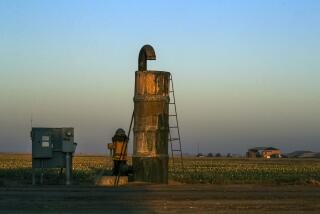Judges Weigh Pact to End Water War
- Share via
Signaling the possible end to a quarter of a century of politically charged litigation over Los Angeles’ use of Owens Valley ground water, a state appellate court is preparing to rule on a recently completed agreement that will help repair some of the environmental damage to the once-fertile valley.
Under the agreement, spelled out in a 40-page “memorandum of understanding” submitted earlier this month by negotiators for the city Department of Water and Power, Inyo County, two state agencies and two environmental groups, the DWP would allow water to flow once more through a 60-mile stretch of the Owens River. In addition, it would provide for establishment or restoration of several wildlife habitats at lakes, ponds and wetlands and a new fishery along the re-watered riverbed.
The lower Owens River has been largely dry since the city water agency opened its first aqueduct in 1913, diverting the water--runoff from the eastern Sierra--233 miles south to the growing, semiarid metropolis that would one day become the nation’s second-largest city.
Sierra runoff, tapped initially from the Owens River and later also from streams feeding Mono Lake north of the valley, is the city’s biggest source of water. The city’s storied system of capturing that runoff has made it persona non grata with environmental groups and residents of the valley, where farmlands turned into dusty desert and the saline Owens Lake, which the river had fed, evaporated.
*
Over the years, the city’s thirst has touched off various legal and environmental battles. The one awaiting resolution before the 3rd District Court of Appeal in Sacramento had its origins in 1970, when the DWP opened its second aqueduct and markedly increased its pumping of ground water. Inyo County, which covers most of the valley, sued in 1972, contending that Los Angeles should have done an environmental impact report before it began pumping. The county claimed that the pumping was lowering the water table, causing the widespread death of trees and other vegetation and destroying wildlife habitats.
The city was ordered to prepare an EIR, but the court found its first two efforts--in 1976 and 1979--inadequate. The city’s third EIR, in which it acknowledged that it had inflicted serious damage in the valley, was submitted in 1991 but has not been ruled on by the court.
The city of Los Angeles and Inyo County signed a historic, much-heralded agreement in 1991 that confirmed the city’s rights to water in the area but restricted ground-water pumping, especially in drought periods. The city agreed to pay for measures to offset some previous environmental harm.
But the court refused to end the case and, citing the high level of public interest, in 1993 invited the state Lands Commission, the state Department of Fish and Game, the Sierra Club and the Owens Valley Committee of community activists to join the case.
“Much to our surprise and regret, the case stayed open,” said Greg James, director of the Inyo County Water Department. He said his agency moved from adversary to mediator as the sometimes acrimonious, six-way negotiations over environmental reparations plodded on over the last five years.
City water officials said they have followed the new pumping regulations for several years, but the largest of the mitigation measures--the river re-watering--has been delayed pending court resolution of the case.
While negotiators believe that they have a document that everyone can live with, they still need to win official approval from the agencies they represent. The Los Angeles Board of Water and Power Commissioners is scheduled to vote on the pact Feb. 4 and then forward a recommendation to the City Council.
The court canceled a hearing that had been set for Friday when it learned that the parties had reached an agreement earlier this month. No new court date has been scheduled yet, but several officials involved in the case expect that it could be finally resolved within the coming months.
“I don’t know of anyone who doesn’t want to deal with this expeditiously,” said Sierra Club attorney Larry Silver.
*
DWP officials say they have not yet tallied the costs of the mitigation projects, but estimated the tab for the largest of the undertakings--restoring the stretch of river--at about $10 million. The DWP will allow some of the water it siphons from its aqueduct’s intake point, midway between the towns of Big Pine and Independence, to flow once more into the riverbed for 60 miles south to near where the river used to empty into what was once Owens Lake. At that point, it will be allowed to pump at least some of the water back into the aqueduct for the trip to Los Angeles.
Glenn Singley, the DWP’s Northern District engineer, said the river re-watering and other mitigation measures could take 12% of the water the city draws from the Sierra runoff in any given year. On average, 60% of the city’s water supply comes from the Sierra; the rest is purchased from other water agencies.
Los Angeles Councilwoman Ruth Galanter, who chairs the council’s Commerce, Natural Resources and Energy Committee, hailed the agreement as evidence that the city and DWP are “committed to doing things with more sensitivity to the environment,” a marked departure from the prevailing attitudes during much of the nearly nine decades the city has been helping itself to Sierra water.
“A lot of this is about chickens coming home to roost, and they are very, very old chickens,” Galanter said, noting that much of the restoration work would ease conditions stemming from city actions in the early part of the century and not just what happened with the 1970 ground-water pumping.
Some officials said the agreement may have an even bigger impact if it heals some of the decades-old bitter feelings.
“I think it should go a long way toward having a better feeling between the people who live up here and the city,” said Bob Michener, chairman of the Inyo County Board of Supervisors, who will urge his colleagues to sign off on the negotiated agreement.
“This was a long time, a lot of work and a lot of costs for everybody over all these years, and I think it is in the best interests of all concerned that we be allowed to move forward with this.”
(BEGIN TEXT OF INFOBOX / INFOGRAPHIC)
Water Pact
In an agreement resolving 25 years of litigation over Los Angeles’ use of Owens Valley water, the Department of Water and Power will restore water to a 60-mile stretch of the Owens River and revitalize or enhance wetlands, a fishery and lakes and ponds near the river. The plan was negotiated with Inyo County, two state agencies and two environmental groups.
More to Read
Sign up for Essential California
The most important California stories and recommendations in your inbox every morning.
You may occasionally receive promotional content from the Los Angeles Times.











